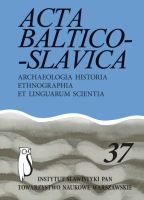Uwagi o leksyce polszczyzny na Litwie na pograniczu litewsko-łotewsko-białoruskim
Observations on the Polish lexis in Lithuania on the borderland of Lithuania, Latvia and Belarus
Author(s): Halina KaraśSubject(s): Language and Literature Studies
Published by: Instytut Slawistyki Polskiej Akademii Nauk
Keywords: Lithuania; borderland; languages contacts; lexical Borderland elements
Summary/Abstract: The paper comments on the lexicon of Polish on the borderland of Lithuania, Latvia and Belarus (in the Zarasai district and the Ignalina district in Lithuania). The remarks, illustrated with selected examples, have been formulated on the basis of data gathered during field research in 2000–2001 and 2010–2011. The paper aims primarily at discussing the extent to which the collected material contributes to the state-of-the-art knowledge on the vocabulary of the North-Eastern Borderlands; the author analyzes the types of words present in the collected material in order to specify whether they are generally attested and well documented, or conversely – less known and only occasionally considered in literature. A large part of the collected material consists of vocabulary well known in Lithuania, and often in the whole area of the North-Eastern Borderlands. These include old expressions of various origin typical of the Eastern Borderlands, richly documented in works devoted to the Polish language of the North-Eastern Borderlands; loans from Lithuanian and Belorussian; or Polish archaic forms, e.g. asystentka ‘maid of honour’, budni ‘usual, ordinary’, fest ‘church fair’, gadzina ‘viper’, hurba ‘snowbank’, karszun ‘hawk’. Another numerous group are newer loanwords from Russian and Lithuanian, popularised in the post-war period, as well as in the recent years along with the changing role of the Lithuanian language, e.g. elektra ‘electric light, electricity’, awtoławka ‘travelling shop’, balnica ‘hospital’. A small, yet extremely interesting for researchers, part of the lexis is composed of vocabulary not so well known in the North-Eastern Borderlands or in Lithuania, regionally bound (exhibited solely in the examined areas or in two former tightly-knit Polish-speaking areas), with limited frequency (rare words, appearing in various regions, yet seldom recognized), or restricted as far as the chronology is concerned (not attested presently, until now known only from older, pre-war sources, mainly from the works of Halina Turska), e.g. bracienik ‘cousin’, ciuszka ‘blowhole’, czeladź ‘children, offspring’, lun ‘marsh, swamp’, babaczka ‘bow tie’, murawiejnik ‘anthill’, ciełuszutka ‘heiferdim’, światleć ‘to shine’. A separate group encompasses words previously undocumented in literature, e.g. wieczuruszkować ‘to go to soirees, parties in the evening’, including the unknown word-formation variants, e.g. walaniantówka ‘epilepsy’ vs. walentaczka/walantaczka, or the regionally-bound diminutive forms with typical suffixes, today rare, e.g. buteleniatka ‘bottledim’, chustalutka ‘handkerchiefdim’. It is worth emphasizing that certain parts of the described vocabulary might still be commonly used, however the scarcity of extensive lexical research, as well as the lack of a full dictionary of Polish of the North-Eastern Borderlands render it impossible to resolve this question.
Journal: Acta Baltico Slavica
- Issue Year: 2013
- Issue No: 37
- Page Range: 359-382
- Page Count: 24
- Language: Polish

